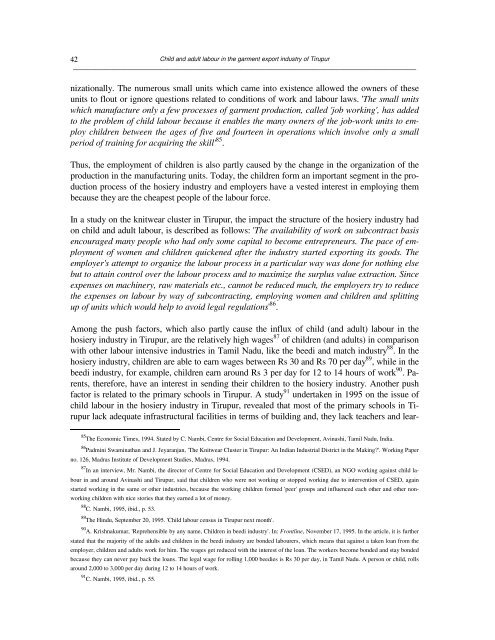You also want an ePaper? Increase the reach of your titles
YUMPU automatically turns print PDFs into web optimized ePapers that Google loves.
42<br />
<strong>Child</strong> <strong>and</strong> <strong>adult</strong> <strong>labour</strong> <strong>in</strong> <strong>the</strong> <strong>garment</strong> <strong>export</strong> <strong>in</strong>dustry <strong>of</strong> Tirupur<br />
──────────────────────────────────────────────────────────────────────────────────────────────<br />
nizationally. The numerous small units which came <strong>in</strong>to existence allowed <strong>the</strong> owners <strong>of</strong> <strong>the</strong>se<br />
units to flout or ignore questions related to conditions <strong>of</strong> work <strong>and</strong> <strong>labour</strong> laws. 'The small units<br />
which manufacture only a few processes <strong>of</strong> <strong>garment</strong> production, called 'job work<strong>in</strong>g', has added<br />
to <strong>the</strong> problem <strong>of</strong> child <strong>labour</strong> because it enables <strong>the</strong> many owners <strong>of</strong> <strong>the</strong> job-work units to employ<br />
children between <strong>the</strong> ages <strong>of</strong> five <strong>and</strong> fourteen <strong>in</strong> operations which <strong>in</strong>volve only a small<br />
period <strong>of</strong> tra<strong>in</strong><strong>in</strong>g for acquir<strong>in</strong>g <strong>the</strong> skill' 85 .<br />
Thus, <strong>the</strong> employment <strong>of</strong> children is also partly caused by <strong>the</strong> change <strong>in</strong> <strong>the</strong> organization <strong>of</strong> <strong>the</strong><br />
production <strong>in</strong> <strong>the</strong> manufactur<strong>in</strong>g units. Today, <strong>the</strong> children form an important segment <strong>in</strong> <strong>the</strong> production<br />
process <strong>of</strong> <strong>the</strong> hosiery <strong>in</strong>dustry <strong>and</strong> employers have a vested <strong>in</strong>terest <strong>in</strong> employ<strong>in</strong>g <strong>the</strong>m<br />
because <strong>the</strong>y are <strong>the</strong> cheapest people <strong>of</strong> <strong>the</strong> <strong>labour</strong> force.<br />
In a study on <strong>the</strong> knitwear cluster <strong>in</strong> Tirupur, <strong>the</strong> impact <strong>the</strong> structure <strong>of</strong> <strong>the</strong> hosiery <strong>in</strong>dustry had<br />
on child <strong>and</strong> <strong>adult</strong> <strong>labour</strong>, is described as follows: 'The availability <strong>of</strong> work on subcontract basis<br />
encouraged many people who had only some capital to become entrepreneurs. The pace <strong>of</strong> employment<br />
<strong>of</strong> women <strong>and</strong> children quickened after <strong>the</strong> <strong>in</strong>dustry started <strong>export</strong><strong>in</strong>g its goods. The<br />
employer's attempt to organize <strong>the</strong> <strong>labour</strong> process <strong>in</strong> a particular way was done for noth<strong>in</strong>g else<br />
but to atta<strong>in</strong> control over <strong>the</strong> <strong>labour</strong> process <strong>and</strong> to maximize <strong>the</strong> surplus value extraction. S<strong>in</strong>ce<br />
expenses on mach<strong>in</strong>ery, raw materials etc., cannot be reduced much, <strong>the</strong> employers try to reduce<br />
<strong>the</strong> expenses on <strong>labour</strong> by way <strong>of</strong> subcontract<strong>in</strong>g, employ<strong>in</strong>g women <strong>and</strong> children <strong>and</strong> splitt<strong>in</strong>g<br />
up <strong>of</strong> units which would help to avoid legal regulations' 86 .<br />
Among <strong>the</strong> push factors, which also partly cause <strong>the</strong> <strong>in</strong>flux <strong>of</strong> child (<strong>and</strong> <strong>adult</strong>) <strong>labour</strong> <strong>in</strong> <strong>the</strong><br />
hosiery <strong>in</strong>dustry <strong>in</strong> Tirupur, are <strong>the</strong> relatively high wages 87 <strong>of</strong> children (<strong>and</strong> <strong>adult</strong>s) <strong>in</strong> comparison<br />
with o<strong>the</strong>r <strong>labour</strong> <strong>in</strong>tensive <strong>in</strong>dustries <strong>in</strong> Tamil Nadu, like <strong>the</strong> beedi <strong>and</strong> match <strong>in</strong>dustry 88 . In <strong>the</strong><br />
hosiery <strong>in</strong>dustry, children are able to earn wages between Rs 30 <strong>and</strong> Rs 70 per day 89 , while <strong>in</strong> <strong>the</strong><br />
beedi <strong>in</strong>dustry, for example, children earn around Rs 3 per day for 12 to 14 hours <strong>of</strong> work 90 . Parents,<br />
<strong>the</strong>refore, have an <strong>in</strong>terest <strong>in</strong> send<strong>in</strong>g <strong>the</strong>ir children to <strong>the</strong> hosiery <strong>in</strong>dustry. Ano<strong>the</strong>r push<br />
factor is related to <strong>the</strong> primary schools <strong>in</strong> Tirupur. A study 91 undertaken <strong>in</strong> 1995 on <strong>the</strong> issue <strong>of</strong><br />
child <strong>labour</strong> <strong>in</strong> <strong>the</strong> hosiery <strong>in</strong>dustry <strong>in</strong> Tirupur, revealed that most <strong>of</strong> <strong>the</strong> primary schools <strong>in</strong> Tirupur<br />
lack adequate <strong>in</strong>frastructural facilities <strong>in</strong> terms <strong>of</strong> build<strong>in</strong>g <strong>and</strong>, <strong>the</strong>y lack teachers <strong>and</strong> lear-<br />
85 The Economic Times, 1994. Stated by C. Nambi, Centre for Social Education <strong>and</strong> Development, Av<strong>in</strong>ashi, Tamil Nadu, <strong>India</strong>.<br />
86 Padm<strong>in</strong>i Swam<strong>in</strong>athan <strong>and</strong> J. Jeyaranjan, 'The Knitwear Cluster <strong>in</strong> Tirupur: An <strong>India</strong>n Industrial District <strong>in</strong> <strong>the</strong> Mak<strong>in</strong>g?'. Work<strong>in</strong>g Paper<br />
no. 126, Madras Institute <strong>of</strong> Development Studies, Madras, 1994.<br />
87 In an <strong>in</strong>terview, Mr. Nambi, <strong>the</strong> director <strong>of</strong> Centre for Social Education <strong>and</strong> Development (CSED), an NGO work<strong>in</strong>g aga<strong>in</strong>st child <strong>labour</strong><br />
<strong>in</strong> <strong>and</strong> around Av<strong>in</strong>ashi <strong>and</strong> Tirupur, said that children who were not work<strong>in</strong>g or stopped work<strong>in</strong>g due to <strong>in</strong>tervention <strong>of</strong> CSED, aga<strong>in</strong><br />
started work<strong>in</strong>g <strong>in</strong> <strong>the</strong> same or o<strong>the</strong>r <strong>in</strong>dustries, because <strong>the</strong> work<strong>in</strong>g children formed 'peer' groups <strong>and</strong> <strong>in</strong>fluenced each o<strong>the</strong>r <strong>and</strong> o<strong>the</strong>r nonwork<strong>in</strong>g<br />
children with nice stories that <strong>the</strong>y earned a lot <strong>of</strong> money.<br />
88 C. Nambi, 1995, ibid., p. 53.<br />
89 The H<strong>in</strong>du, September 20, 1995. '<strong>Child</strong> <strong>labour</strong> census <strong>in</strong> Tirupur next month'.<br />
90 A. Krishnakumar, 'Reprehensible by any name, <strong>Child</strong>ren <strong>in</strong> beedi <strong>in</strong>dustry'. In: Frontl<strong>in</strong>e, November 17, 1995. In <strong>the</strong> article, it is fur<strong>the</strong>r<br />
stated that <strong>the</strong> majority <strong>of</strong> <strong>the</strong> <strong>adult</strong>s <strong>and</strong> children <strong>in</strong> <strong>the</strong> beedi <strong>in</strong>dustry are bonded <strong>labour</strong>ers, which means that aga<strong>in</strong>st a taken loan from <strong>the</strong><br />
employer, children <strong>and</strong> <strong>adult</strong>s work for him. The wages get reduced with <strong>the</strong> <strong>in</strong>terest <strong>of</strong> <strong>the</strong> loan. The workers become bonded <strong>and</strong> stay bonded<br />
because <strong>the</strong>y can never pay back <strong>the</strong> loans. The legal wage for roll<strong>in</strong>g 1,000 beedies is Rs 30 per day, <strong>in</strong> Tamil Nadu. A person or child, rolls<br />
around 2,000 to 3,000 per day dur<strong>in</strong>g 12 to 14 hours <strong>of</strong> work.<br />
91 C. Nambi, 1995, ibid., p. 55.


















